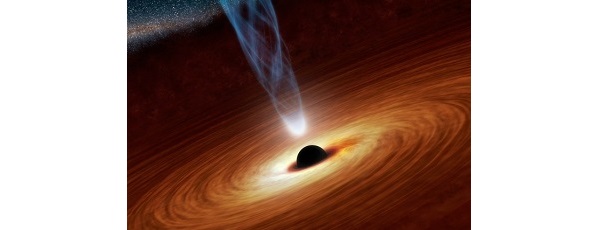Black holes are objects so compact that not even light can escape them and they are described by solutions of Einstein’s equations characterized by very few physical parameters, such as mass, angular momentum and electric charge.
The American physicist John Wheeler, to whom we might owe the paternity of the term “black hole”, summed up this extreme simplicity by saying that “black holes have no hair”, which contrasts sharply with the enormous complexity of those stars which, having run out of nuclear fuel, can collapse and form black holes. This contrast, between the simplicity of black holes and the complexity of stars, is at the origin of the “paradox of information loss” formulated by Stephen Hawking.
The famous British physicist, in the early 1970s, showed that black holes can “evaporate” by emitting a radiation that depends only on the quantities (mass, angular momentum and charge) that characterize the outside of the black hole.
The information on the very complex structure of the original star would therefore be lost if the black hole evaporated completely.
The “paradox” is based on the description of the star that forms the black hole and its gravitational field using classical physics on the one hand, while the radiation in which the black hole evaporates is described using quantum physics on the other.
An international research group involving Roberto Casadio of the INFN Section of Bologna and of the Department of Physics and Astronomy “A. Righi ”of the University of Bologna has obtained results that significantly modify this theoretical framework.
In an article written together with Professor Xavier Calmet and PhD student Folkert Kuipers of the University of Sussex (UK) and Professor Stephen Hsu of Michigan State University (USA), recently published in the journal Physical Review Letters, it was shown that the gravitational field instead depends on the internal structure of the source according to quantum physics.
Hence, we can say that both around a star and outside a black hole there are “quantum hair” which, although very weak, can contain the information necessary to resolve the paradox.
This result has a historical parallel in the quantum description of atoms which, at the beginning of the last century, explained their stability and does not require any drastic revolution of the quantum field theories used today to describe nature in a unified way.
The American physicist John Wheeler, to whom we might owe the paternity of the term “black hole”, summed up this extreme simplicity by saying that “black holes have no hair”, which contrasts sharply with the enormous complexity of those stars which, having run out of nuclear fuel, can collapse and form black holes. This contrast, between the simplicity of black holes and the complexity of stars, is at the origin of the “paradox of information loss” formulated by Stephen Hawking.
The famous British physicist, in the early 1970s, showed that black holes can “evaporate” by emitting a radiation that depends only on the quantities (mass, angular momentum and charge) that characterize the outside of the black hole.
The information on the very complex structure of the original star would therefore be lost if the black hole evaporated completely.
The “paradox” is based on the description of the star that forms the black hole and its gravitational field using classical physics on the one hand, while the radiation in which the black hole evaporates is described using quantum physics on the other.
An international research group involving Roberto Casadio of the INFN Section of Bologna and of the Department of Physics and Astronomy “A. Righi ”of the University of Bologna has obtained results that significantly modify this theoretical framework.
In an article written together with Professor Xavier Calmet and PhD student Folkert Kuipers of the University of Sussex (UK) and Professor Stephen Hsu of Michigan State University (USA), recently published in the journal Physical Review Letters, it was shown that the gravitational field instead depends on the internal structure of the source according to quantum physics.
Hence, we can say that both around a star and outside a black hole there are “quantum hair” which, although very weak, can contain the information necessary to resolve the paradox.
This result has a historical parallel in the quantum description of atoms which, at the beginning of the last century, explained their stability and does not require any drastic revolution of the quantum field theories used today to describe nature in a unified way.
UniBO Magazine:https://magazine.unibo.it/archivio/2022/03/17/i-buchi-neri-hanno-201ccapelli-quantistici201d


